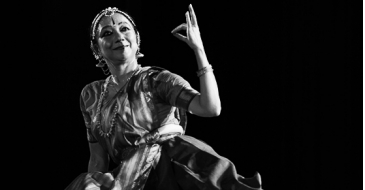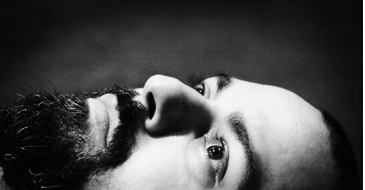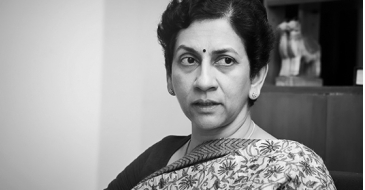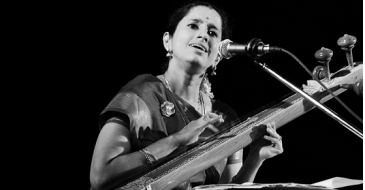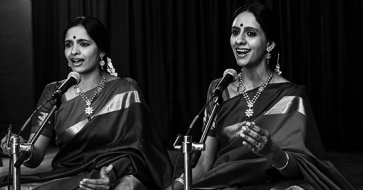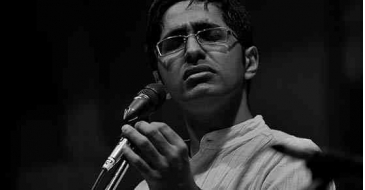The concept of vocal aesthetics hasn’t always been synonymous with Carnatic music. And yet, it’s the job of a performer to engage the audience. What role does the vocal aesthetic really play in our music?
I think aesthetics has always existed as part of our music. Those who have thought about it and delved deep into the ocean it presents have always found it. It’s just like a pearl inside the oyster— it needs to be carefully unearthed. While this may sound cliche, this is something I’ve always felt.
That’s the secret behind aesthetics: it’s difficult to find, and its discovery requires sadhana and practice. To answer your question broadly, I think it’s always been there.
We’ve heard some of the best examples of the influence of aesthetics in Carnatic music. In fact, when we begin the discussion, stalwarts such as Ramnad Krishnan come to mind. And how can we forget MS Amma? When we think of putting Carnatic music on a global stage and demonstrating the aesthetic value in our system to an international audience, MS Amma comes to mind almost instantly.
Is aesthetic synonymous with a melodious voice or tone, then?
I feel that it is not just about the voice. In fact, it’s much more than that. There is voice or, in instrumental cases, the quality of the instrument someone is playing; but it goes beyond that. Just standing unwaveringly in one note can be a demonstration of aesthetic. We are incorporating so much in our music – lyrics, bhavam, melody, layam, etc. It’s a very difficult structure, and we’re talking about different kinds of compositions that incorporate a variety of elements, not just melody and tune. The question, then, is how do we really define aesthetics in this space?
I think the first thing is adherence to sruthi. That itself brings so much value to what you’re doing. Sruthi suddham gives a sense of purity that can capture a magical aspect of aesthetic. Second, if singing a lyric, then as an artist, I must be able to give that lyric the importance it requires while showing pure melody in some places, kozhaivu in some places, azhuththam in some places, and spuritham in some places.
Akaara shuddham is the backbone of aesthetics in our music. Almost every aspect of Carnatic music is borne from the clarity we can establish through akaara
In a raga elaboration, the aesthetic is also about the syllables. I think when we sing a sketch of a raga, we should focus on akaara rather than the integration of syllables. For instance, the ‘oo’ or ‘hmm’ sounds – I personally try not to use them when elaborating a raga as I feel it is not aesthetically-pleasing.
So those elements are inbuilt in our system, in a way.
Completely. Historically if you look into the evolution of Carnatic music, we’ve had a clear established pattern of the art form.
When you examine the core of Carnatic music, it has been composed by great composers who were musicians themselves. They did not compose without gnyaanam of the raga or of the song. Instead, it flowed seamlessly, from the conceptualization to the presentation of a krithi. While much of our music was integrated into the presentation format, being performed on stages and in courts in order for composers to earn their livelihood, it was rarely conceptualized with that purpose in mind. Therefore, our music was borne out of bhakti, out of emotion, and a plethora of sentiment that went into each of those compositions. Each piece had story value.
This sort of aesthetic has been established for centuries. However, it’s entered the subtext of the art form now.
If someone asks me if there is aesthetics in Carnatic music, I’d say “yes, there is an abundance of aesthetic value. We just need to find it”
We often choose to look for aesthetics at a performance level. And yet, there are aspects that are interwoven from the nascent stages of the art form.
Aesthetics has been included right from our initial exercises: sarali varisais, alankarams, and dhattu varisais, for instance. These are the stepping stones of voice culture in our music.
In that sense, aesthetic is one of the first things Purandaradasa thought of when he did all of these things. He composed these exercises to train and culture the voice itself.
Can aesthetics be found within the blueprint of a composition, then?
Definitely. Our composers have included aesthetics very early on in the form of swaraaksharas. You can see that in various kirthanams: such beautiful incorporations of that. ‘Swaraakshara’ is an instance where the swaram and the lyric match. If you take Shyama Sastry’s compositions, for instance, he has brought in so many examples of Swaraakshara.
Another important aspect about aesthetics in terms of lyrical content is bhavam: specifically, how our composers have inbuilt this bhavam to match the ragam and talam to bring about aesthetics.
In my opinion, it’s all there—there is so much aesthetics in our lyrics, our mathematical structure, and, especially, our ragas.
Does each raga have its own identity and aesthetic quotient?
Definitely. A raga like poorvikalyani, for instance, I would want to be very sedate and meditative whereas something like pantuvarali, I would even sing on a bad voice day. I tell everybody – if your voice isn’t opening up, pantuvarali can do the trick. The raga itself is like that.
I firmly believe that when we handle each raga, the voice usage changes, the thought process changes, so much so that each raga should be treated like its own raga devatha, as my guru would say. When it happens, it’s a beautiful thing.
Raga to raga, there is so much aesthetic variability, which makes our system so enchanting and yet, equally difficult. In a way, that has led to it becoming a niche system.
Combating this niche is where aesthetics play an integral role. We really need to cultivate people into being rasikas, especially for the value of the music being offered to them. Aesthetic value is the bridge that connects the artistic technique with the ears of the audience.
While composers have cultivated a sense of aesthetic through their compositions, the kutcheri format is another avenue of aesthetic value. Can you speak a little about that?
The trajectory of a kutcheri is its own aesthetic exercise. The varnam, for instance, warms up the voice and seasons it for the performance to come. In terms of krithis, the way we give our voice to a variety of compositions and formats adds aesthetic value as well. It’s very versatile, from raga structures to formats of pieces. All these things make a Carnatic concert interesting. Ultimately, though, the content is king.
If the content is presented aesthetically, the kutcheri transforms from an event to a journey for both the performer and the rasika
What role does kanakku, the mathematical intellect and spontaneity of an artist, play in packaging a kutcheri that has aesthetic value?
Math has always played an important role in our system. The element of laya is inbuilt from the varnam stage, or even earlier. Kanakku has been shown to be aesthetic as well, especially when woven seamlessly into a given framework. The ways in which people like KV Narayanaswamy, GNB, Lalgudi Sir, S. Kalyaranaman, and TRS Sir have represented this are perhaps some of the best examples of aesthetic presentation of kanakku. Essentially, it is a question of sadhana: how you practice, adapt to the ragas, and sing appropriate swaras to give the kanakku aesthetic flavor, for instance.
Do you use the interaction with an audience while on stage to measure the reach of the aesthetic?
That interaction is intangible: I don’t think I could summarize it in a few words and tell you. It also depends on how open rasikas are about their appreciation and how demonstrative they are. After all, you are trying to please them. Without lowering our standards of what we’re trying to do, if we’re able to bring the audience along, it’s a wonderful feeling. A lot of this understanding comes from experience as well. We feel that the aesthetics reach the audience when we sing to an uninitiated audience, one that is entirely new to the system, and they are moved by the music. The interaction with the audience is special in its own way.
Is it also a question of sound quality – the overt experience, perhaps?
Nowadays, we engage in the discussion of a sound system and the perfect mic set-up, but all of that wasn’t prevalent in the early days. Some of the recordings we, both as musicians and rasikas ourselves, fall back on to listen to have been audially of poor quality. Yet, this shows that our music’s aesthetic value is much more than just the sound. Content is equally important.
Given the fact that our environment has now evolved, our generation must attempt to blend the two elements optimally– content and sound quality.
Technology has given us too, too much input: more than we can process in this one lifetime. With all the input, how do we present it aesthetically without compromising on the content in its purest form?
Again, that is derived from sadhana and contemplation. Some of our past masters have really shown us how to combine aesthetics with the content. Our responsibility as the current generation of artists is to take that technique forward, enhancing our music with today’s audio equipment without diluting the content.
And then, there’s the consideration of the voice itself.
The voice is the vehicle – it’s like a bird in flight. The bird in flight is the enchanting one - majestic in its own right, with a distinct personality. The voice is similar, and how the artist uses that voice to convey his or her message is a very individualistic experience. A bird uses its aerodynamics to fly; I think the same thing applies to the voice. The first step is for a performer to understand his or her voice and what it can do in different ragas - in that way, the voice culture has to incorporate different formats. For example, when I sing a raga as a lady vocalist, I focus on akaara shudhdham.
The initial exercises also give you lung power – an integral aspect of a good voice. Being able to use a rounded breath and incorporate that in the voice through long stretches of kaarvais is essential: that’s when an audience really relaxes. As much as lightning sangathis create excitement, the kaarvais still the mind and make people relax. All of these things must be incorporated: lightning sangathis, jaarus, spurithams, and kaarvais.

While Hindustani musicians have given a lot of importance to voice culture right from the beginning, our structure is an amalgamation of a variety of elements with lyrics and compositions in abundance. But if we’re able to understand that the axle of all of these things is the raga, then we can dwell on that and cultivate our voice to establish these ragas and bring them out in our desired manner. This will allow us to absorb voice culture into our system as well.
As much as you focus on saadhana yourself, there was a rather large period when you weren’t singing.
Eight years, in fact. I didn’t sing for various reasons. While I was performing quite regularly, I took a hiatus from 1993-2001 while I was away from Chennai. I didn’t sing at all at that time. No practice, no listening: I cut myself off from music, maybe because at the time, it was an overwhelming presence in my life. Now, I can’t imagine a day without it.
How did you re-enter the performance sphere?
When I came back, it was all accidental. After a spontaneously-arranged performance for Nellai Sabha, there was no looking back. I do believe I was lucky: there was no setback in my voice. But I had to train it again. The retraining process happened in spurts and took some getting used to, especially after such a long time away from the stage – that period was tough. The voice took a beating; I used to pick up infections. It wasn’t necessarily easy, coming back.
By the grace of God, my voice doesn’t inherently require too much rehabilitation– although I do practice a lot. However, each person’s journey is different. The musician has to understand his own voice for himself.
It’s been many years since that hiatus. What did you learn from that experience?
If anything, it is that the voice has to be in use – I’ve learnt that from that experience. Because if you don’t sing for 3 days, everyone can tell. I genuinely believe that. You have to attempt everything with your voice: the conceptualization process isn’t enough. It’s important to execute your ideas multiple times and sharpen your voice with every attempt.
You have also had the unique experience of participating in jugalbandhis with two renowned Hindustani vocalists. Tell us more about those concerts.
My first experience of singing a jugalbandhi was with the late Lakshmi Shankar aunty. This was about 5 years back in San Diego – she was 80 by that time, and not willing to perform, but Pandit Ravi Shankar Ji’s foundation and IFAASD, San Diego wanted this jugalbandhi to happen. I was roped in because they thought I could give her the support. I spent 10 days with her, just to understand each other, and to try to cajole her into singing a little bit every day – Pt. Ravi Shankar’s wife, Sukanya ji, was also with us.
It was a beautiful experience because it made me understand how much importance Hindustani musicians place on the raga system in the Hindustani framework itself. I have always been more krithi oriented personally – the importance of the raga, and what is done to elaborate it so extensively really struck me during those days with Lakshmi Shankar ji.

For the actual concert, Lakshmi aunty wanted it to be very clearly demarcated. She said, “I don’t want us to compromise on our individual systems.” She planned that we do an alapana together, then she would sing a tarana and wanted me to follow that with a pallavi – mind you, she wanted a technically-difficult pallavi. She wanted people to know the strengths of both Carnatic and Hindustani music is. Of course, we did other pieces together as well. She was a remarkable lady.
And the second?
The other experience was singing with Arati Ankalikar- that was conceptualized by Carnatica for Bharat Sangeet Utsa. We were looking for someone who’d match my sruthi as I didn’t want to sing too high and risk damaging my voice. Arati ji and I got along beautifully, which helped us formulate a concert which was very cohesive. And yet, while preparing, I made sure I had all my gamakkams perfectly in place in order to present my portion as Carnatic as possible.
Did those concerts give you a new perspective on aesthetic, possibly one you hadn’t explored yourself?
Both Lakshmi ji and Arati ji are very open-throated musicians – the more open the voice is, the more lasting it is and the more power it has. These are things that are take-home from such musicians. The key, so-to-speak, is power with aesthetics: you need to reach there. And it’s not easy. Sometimes when I listen to Carnatic music, I feel that there are certain places where we can add more aesthetic value. It’s undoubtedly an ongoing journey for every musician.
Sometimes, the more you sing a piece, the more you question the characteristics of the piece – did it have as many sangathis as are being sung right now? Even as you sing, you attempt to develop the aesthetic as well.
And yet, minimalism is also equally important, right? You wouldn’t want to pepper a krithi with as many gamakkams as possible.
Exactly. A large part of the aesthetic is not overburdening your music. For example, knowing where a kaarvai works better than a brigha is an essential part of aesthetic delivery.
That process is intuitive. Sometimes it happens on stage rather than in practice. Very often, certain things happen on stage that you might not have thought of while by yourself, practicing. Something just sparks on stage.
Those sparks come from certain inspirations. It’s often a byproduct of the experience, the environment. Many times, they are triggered by our accompanists and the ideas that they execute on stage, many of which I have not considered myself. A myriad of these concepts come together to spur flashes of creativity in a kutcheri.
I’d like to think those moments are what make a kutcheri indescribable.
Striking a balance between flair and minimalism is also a facet of an artist’s experience, I’d assume.
100%. A musician grows from one kutcheri to the next, so it takes us a while to figure out what works. Sometimes, what we perceive as successful on stage is the area we felt we could have changed the most after the kutcheri. The vice-versa is also true. It’s a constantly dynamic process.
After all these years, is there any part of your voice that still surprises you?
Many parts. Largely because of the Carnatic system itself, the variety in the system, and the dynamism it offers, I am still discovering aspects of my voice. It’s my very own miracle box.
Interviewed by Lavanya Narayanan
0 comments Comments
SIGN UP TO RECEIVE OUR WEEKLY NEWSLETTER IN YOUR INBOX





